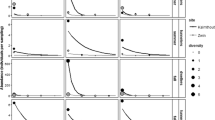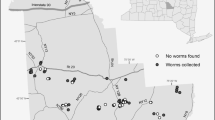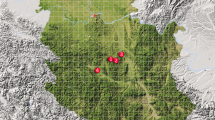Abstract
The ‘New Zealand flatworm’, Arthurdendyus triangulatus, is a native of the South Island of New Zealand, which has established in the UK, Ireland and the Faroe Islands. In its introduced range, it is a predator of lumbricid earthworms. To assess the impact of A. triangulatus on earthworm species, flatworm distributions were manipulated into ‘high’, control and ‘low’ densities within a replicated field experiment. Earthworm biomass in the ‘high’ flatworm density treatment was significantly lower than the control or ‘low’ treatments. This was due to a reduction in the anecic species Lumbricus terrestris and, to a lesser extent, Aporrectodea longa. There was little evidence of negative effects on other earthworm species, with even a weakly positive relationship between flatworm density and epigeic biomass. Principal components analysis showed a clear separation of anecic species from A. triangulatus, but the epigeic species Lumbricus festivus and Lumbricus rubellus grouped with A. triangulatus, suggesting that they could be benefitting from reduced intraguild competition. Flatworm densities of 0.8 per m2, comparable to natural infestations in grassland, were predicted to give a reduction in total earthworm biomass of c. 20 %. The bulk of this was comprised of a reduction in anecic species biomass. In particular, it is considered that A. triangulatus poses a serious risk to L. terrestris populations, with implications for soil functioning and indigenous earthworm-feeding wildlife.







Similar content being viewed by others
References
Alford DV (1998) Potential problems posed by non-indigenous terrestrial flatworms in the United Kingdom. Pedobiologia 42(5–6):574–578
Alford DV, Hancocks PJ, Parker WE (1995) The potential impact of New Zealand flatworm (Artioposthia triangulata) on agriculture and the environment in England and Wales. Project Number OCS 9323. Ministry of Agriculture, Fisheries and Food, Chief Scientists Group, Cambridge, UK
Anonymous (1964) Annual progress report on research and technical work. Agricultural Entomology Division, Ministry of Agriculture, Belfast
Baird J, Fairweather I, Murchie AK (2005a) Long-term effects of prey-availability, partnering and temperature on overall egg capsule output of ‘New Zealand flatworms’, Arthurdendyus triangulatus. Ann App Biol 146(3):289–301. doi:10.1111/j.1744-7348.2005.040095.x
Baird J, McDowell SDR, Fairweather I, Murchie AK (2005b) Reproductive structures of Arthurdendyus triangulatus (Dendy): seasonality and the effect of starvation. Pedobiologia 49(5):435–442. doi:10.1016/j.pedobi.2005.05.003
Baker GH, Carter PJ, Barrett VJ (1999) Influence of earthworms, Aporrectodea spp. (Lumbricidae), on pasture production in south-eastern Australia. Aust J Agric Res 50(7):1247–1257. doi:10.1071/AR98182
Baker GH, Brown G, Butt K, Curry JP, Scullion J (2006) Introduced earthworms in agricultural and reclaimed land: their ecology and influences on soil properties, plant production and other soil biota. Biol Invasions 8(6):1301–1316. doi:10.1007/s10530-006-9024-6
Bartlett MD, Briones MJI, Neilson R, Schmidt O, Spurgeon D, Creamer RE (2010) A critical review of current methods in earthworm ecology: from individuals to populations. Eur J Soil Biol 46(2):67–73. doi:10.1016/j.ejsobi.2009.11.006
Bengtson SA, Nilsson A, Nordström S, Rundgren S (1976) Effect of bird predation on lumbricid populations. Oikos 27(1):9–12. doi:10.2307/3543424
Bengtson SA, Rundgren S, Nilsson A, Nordström S (1978) Selective predation on lumbricids by golden plover Pluvialis apricaria. Oikos 31(2):164–168. doi:10.2307/3543559
Blackshaw RP (1989) The effects of a calcareous seaweed product on earthworm populations in grassland soil. Biol Agric Hortic 6(1):27–33
Blackshaw RP (1990) Studies on Artioposthia triangulata (Dendy) (Tricladida, Terricola), a predator of earthworms. Ann App Biol 116(1):169–176. doi:10.1111/j.1744-7348.1990.tb06596.x
Blackshaw RP (1991) Mortality of the earthworm Eisenia fetida (Savigny) presented to the terrestrial planarian Artioposthia triangulata (Dendy) (Tricladida, Terricola). Ann App Biol 118(3):689–694. doi:10.1111/j.1744-7348.1991.tb05358.x
Blackshaw RP (1992) The effect of starvation on size and survival of the terrestrial planarian Artioposthia triangulata (Dendy) (Tricladida, Terricola). Ann App Biol 120(3):573–578. doi:10.1111/j.1744-7348.1992.tb04917.x
Blackshaw RP (1995) Changes in populations of the predatory flatworm Artioposthia triangulata and its earthworm prey in grassland. Acta Zool Fenn 196:107–110
Blackshaw RP (1996) Control options for the New Zealand flatworm. In: Brighton crop protection conference, pests & diseases, Brighton, UK, 18–21 November 1996. BCPC, pp 1089–1094
Blackshaw RP, Stewart VI (1992) Artioposthia triangulata (Dendy, 1894), a predatory terrestrial planarian and its potential impact on lumbricid earthworms. Agric Zool Rev 5:201–219
Blackshaw RP, Moore JP, Alston R (1996) Removal trapping to control Artioposthia triangulata. Ann App Biol 129(2):355–360. doi:10.1111/j.1744-7348.1996.tb05758.x
Bloch D (1992) A note on the occurrence of land planarians in the Faroe Islands. Fródskaparrit 38:63–68
Boag B (2000) The impact of the New Zealand flatworm on earthworms and moles in agricultural land in western Scotland. Asp Appl Biol 62:79–84
Boag B, Yeates GW (2001) The potential impact of the New Zealand flatworm, a predator of earthworms, in Western Europe. Ecol Appl 11(5):1276–1286. doi:10.2307/3060919
Boag B, Palmer LF, Neilson R, Chambers SJ (1994) Distribution and prevalence of the predatory planarian Artioposthia triangulata (Dendy) (Tricladida: Terricola) in Scotland. Ann App Biol 124(1):165–171. doi:10.1111/j.1744-7348.1994.tb04124.x
Boag B, Evans KA, Neilson R, Yeates GW, Johns PM, Mather JG, Christensen OM, Jones HD (1995) The potential spread of terrestrial planarians Artioposthia triangulata and Australoplana sanguinea var. alba to continental Europe. Ann App Biol 127(2):385–390. doi:10.1111/j.1744-7348.1995.tb06682.x
Boag B, Palmer LF, Neilson R, Legg R, Chambers SJ (1997) Distribution, prevalence and intensity of earthworm populations in arable land and grassland in Scotland. Ann App Biol 130(1):153–165. doi:10.1111/j.1744-7348.1997.tb05791.x
Boag B, Yeates GW, Johns PM (1998) Limitations to the distribution and spread of terrestrial flatworms with special reference to the New Zealand flatworm (Artioposthia triangulata). Pedobiologia 42(5–6):495–503
Boag B, Jones HD, Neilson R, Santoro G (1999) Spatial distribution and relationship between the New Zealand flatworm Arthurdendyus triangulata and earthworms in a grass field in Scotland. Pedobiologia 43(4):340–344
Boag B, Deeks L, Orr A, Neilson R (2005) A spatio-temporal analysis of a New Zealand flatworm (Arthurdendyus triangulatus) population in western Scotland. Ann App Biol 147(1):81–88. doi:10.1111/j.1744-7348.2005.00017.x
Boag B, Mackenzie K, McNicol JW, Neilson R (2010a) Sampling for the New Zealand flatworm. Proc Crop Prot North Brit 2010:45–50
Boag B, Neilson R, Jones HD (2010b) Quantifying the risk to biodiversity by alien terrestrial planarians. Asp Appl Biol 104:55–61
Bolker BM, Brooks ME, Clark CJ, Geange SW, Poulsen JR, Stevens MHH, White J-SS (2009) Generalized linear mixed models: a practical guide for ecology and evolution. Trends Ecol Evol 24(3):127–135. doi:10.1016/j.tree.2008.10.008
Bouché MB (1971) Relations entre les structures spatiales et fonctionelles des ecosystems, illustrées par le role pédobiologique des vers de terre. In: Pesson P (ed) La Vie dans les Sols, Aspects Nouveaux, Études Experimentales Gauthier-Villars, Paris, pp 187–209
Bouché MB (1977) Strategies lombriciennes. In: Lohm U, Persson T (eds) Soil organisms as components of the ecosystem, vol 25. Ecological bulletins (Stockholm). Swedish Natural Science Research Council, Stockholm, pp 122–132
Boyle KE, Curry JP, Farrell EP (1997) Influence of earthworms on soil properties and grass production in reclaimed cutover peat. Biol Fertil Soils 25(1):20–26. doi:10.1007/s003740050274
Butt KR (1993) Reproduction and growth of three deep-burrowing earthworms (Lumbricidae) in laboratory culture in order to assess production for soil restoration. Biol Fertil Soils 16(2):135–138. doi:10.1007/bf00369415
Butt KR (2011) Food quality affects production of Lumbricus terrestris (L.) under controlled environmental conditions. Soil Biol Biochem 43(10):2169–2175. doi:10.1016/j.soilbio.2011.06.021
Cannon RJC, Baker RHA, Taylor MC, Moore JP (1999) A review of the status of the New Zealand flatworm in the UK. Ann App Biol 135(3):597–614. doi:10.1111/j.1744-7348.1999.tb00892.x
Chan K-Y, Munro K (2001) Evaluating mustard extracts for earthworm sampling. Pedobiologia 45(3):272–278
Christensen OM, Mather JG (1998) The ‘New Zealand flatworm’, Artioposthia triangulata, in Europe: the Faroese situation. Pedobiologia 42(5–6):532–540
Cleary GP, Corner LAL, O’Keeffe J, Marples NM (2009) The diet of the badger Meles meles in the Republic of Ireland. Mamm Biol 74(6):438–447. doi:10.1016/j.mambio.2009.07.003
Clements RO, Murray PJ, Bentley BR, Henderson IF (1990) Herbage yield and botanical composition over 20 years of a predominantly ryegrass sward treated frequently with phorate pesticide and 3 rates of nitrogen-fertilizer. J Agric Sci 115:23–27. doi:10.1017/S0021859600073871
Clements RO, Murray PJ, Sturdy RG (1991) The impact of 20 years’ absence of earthworms and three levels of N fertiliser on a grassland soil environment. Agric Ecosyst Environ 36(1–2):75–85. doi:10.1016/0167-8809(91)90037-X
DARD (2011) Statistical review of Northern Ireland agriculture 2010. Department of Agriculture and Rural Development, Policy and Economics Division, Belfast
Darwin CR (1859) On the origin of species by means of natural selection, or the preservation of favoured races in the struggle for life. John Murray, London
Ducey PK, West L-J, Shaw G, De Lisle J (2005) Reproductive ecology and evolution in the invasive terrestrial planarian Bipalium adventitium across North America. Pedobiologia 49(4):367–377. doi:10.1016/j.pedobi.2005.04.002
Ducey PK, McCormick M, Davidson E (2007) Natural history observations on Bipalium cf. vagum Jones and Sterrer (Platyhelminthes: Tricladida), a terrestrial broadhead planarian new to North America. Southeast Nat 6(3):449–460. doi:10.1656/1528-7092(2007)6[449:nhoobc]2.0.co;2
Dynes C, Fleming CC, Murchie AK (2001) Genetic variation in native and introduced populations of the ‘New Zealand flatworm’, Arthurdendyus triangulatus. Ann App Biol 139(2):165–174. doi:10.1111/j.1744-7348.2001.tb00393.x
Edwards CA, Bohlen PJ (1996) Biology and ecology of earthworms, 3rd edn. Chapman & Hall, London
Eijsackers H (2011) Earthworms as colonizers of natural and cultivated soil environments. Appl Soil Ecol 50:1–13. doi:10.1016/j.apsoil.2011.07.008
Evans AC, Guild WJ (1948) Studies on the relationships between earthworms and soil fertility. IV. On the life cycles of some British Lumbricidae. Ann App Biol 35(4):471–484
Fraser PM, Boag B (1998) The distribution of lumbricid earthworm communities in relation to flatworms: a comparison between New Zealand and Europe. Pedobiologia 42(5–6):542–553
Funmilayo O (1977) Distribution and abundance of moles (Talpa europaea L.) in relation to physical habitat and food supply. Oecologia 30(3):277–283. doi:10.1007/bf01833635
Gibson PH, Cosens D, Buchanan K (1997) A chance field observation and pilot laboratory studies of predation of the New Zealand flatworm by the larvae and adults of carabid and staphylinid beetles. Ann App Biol 130(3):581–585. doi:10.1111/j.1744-7348.1997.tb07684.x
Goszczyński J, Jedrzejewska B, Jedrzejewski W (2000) Diet composition of badgers (Meles meles) in a pristine forest and rural habitats of Poland compared to other European populations. J Zool 250(4):495–505. doi:10.1111/j.1469-7998.2000.tb00792.x
Green NC, Murchie AK (2006) In-field distributions of the New Zealand flatworm, Arthurdendyus triangulatus (Dendy). Proc Crop Prot North Brit 2006:57–62
Gunn A (1992) The use of mustard to estimate earthworm populations. Pedobiologia 36(2):65–67
Haria AH (1995) Hydrological and environmental impact of earthworm depletion by the New Zealand flatworm (Artioposthia triangulata). J Hydrol 171(1–2):1–3. doi:10.1016/0022-1694(95)02734-7
Haria AH, McGrath SP, Moore JP, Bell JP, Blackshaw RP (1998) Impact of the New Zealand flatworm (Artioposthia triangulata) on soil structure and hydrology in the UK. Sci Total Environ 215(3):259–265. doi:10.1016/s0048-9697(98)00126-0
Heimpel G, Frelich L, Landis D, Hopper K, Hoelmer K, Sezen Z, Asplen M, Wu K (2010) European buckthorn and Asian soybean aphid as components of an extensive invasional meltdown in North America. Biol Invasions 12(9):2913–2931. doi:10.1007/s10530-010-9736-5
Hoogerkamp M, Rogaar H, Eijsackers HJP (1983) Effects of earthworms on grassland on recently reclaimed polder soils in the Netherlands. In: Satchell JE (ed) Earthworm ecology: from Darwin to vermiculture. Chapman and Hall, London, pp 85–105
Johns PM (1998) The New Zealand terrestrial flatworms: a 1997–1998 perspective. Pedobiologia 42(5–6):464–468
Johns PM, Boag B (2003) The spread and distribution of terrestrial planarians (Turbellaria: Tricladida: Geoplanidae) within New Zealand. N Z J Ecol 27(2):201–206
Johns PM, Boag B, Yeates GW (1998) Observations on the geographic distribution of flatworms (Turbellaria: Rhynchodemidae, Bipaliidae, Geoplanidae) in New Zealand. Pedobiologia 42(5–6):469–476
Jones HD, Boag B (1996) The distribution of New Zealand and Australian terrestrial flatworms (Platyhelminthes: Turbellaria: Tricladida: Terricola) in the British Isles—the Scottish survey and MEGALAB WORMS. J Nat Hist 30(7):955–975. doi:10.1080/00222939600770511
Jones HD, Santoro G, Boag B, Neilson R (2001) The diversity of earthworms in 200 Scottish fields and the possible effect of New Zealand land flatworms (Arthurdendyus triangulatus) on earthworm populations. Ann App Biol 139(1):75–92. doi:10.1111/j.1744-7348.2001.tb00132.x
Kruuk H (1978) Foraging and spatial organisation of the European badger, Meles meles L. Behav Ecol Sociobiol 4(1):75–89. doi:10.1007/bf00302562
Kruuk H, Parish T (1981) Feeding specialization of the European Badger Meles meles in Scotland. J Anim Ecol 50(3):773–788. doi:10.2307/4136
Kruuk H, Parish T, Brown CAJ, Carrera J (1979) The use of pasture by the European badger (Meles meles). J Appl Ecol 16(2):453–459. doi:10.2307/2402521
Lawrence AP, Bowers MA (2002) A test of the ‘hot’ mustard extraction method of sampling earthworms. Soil Biol Biochem 34(4):549–552. doi:10.1016/s0038-0717(01)00211-5
Lee KE (1985) Earthworms, their ecology and relationships with soils and land use. Academic Press, London
Lillico S, Cosens D, Gibson P (1996) Studies of the behaviour of Artioposthia triangulata (Platyhelminthes; Tricladida), a predator of earthworms. J Zool 238(3):513–520
Lowe CN, Butt KR (2002a) Growth of hatchling earthworms in the presence of adults: interactions in laboratory culture. Biol Fertil Soils 35(3):204–209. doi:10.1007/s00374-002-0471-7
Lowe CN, Butt KR (2002b) Influence of organic matter on earthworm production and behaviour: a laboratory-based approach with applications for soil restoration. Eur J Soil Biol 38(2):173–176. doi:10.1016/s1164-5563(02)01141-x
MacDonald DW (1983) Predation on earthworms by terrestrial vertebrates. In: Satchell JE (ed) Earthworm ecology, from Darwin to vermiculture. Chapman and Hall, London, pp 393–414
Mellanby K (1971) The mole. The new naturalist series. Collins, London
Moore JP, Dynes C, Murchie AK (1998) Status and public perception of the ‘New Zealand flatworm’, Artioposthia triangulata (Dendy), in Northern Ireland. Pedobiologia 42(5–6):563–571
Moran MD (2003) Arguments for rejecting the sequential Bonferroni in ecological studies. Oikos 100(2):403–405. doi:10.1034/j.1600-0706.2003.12010.x
Murchie AK (2010) Between two stools: dealing with the problem of the New Zealand flatworm. Asp Appl Biol 104:73–78
Murchie AK, Mac An tSaoir S (2006) High densities of ‘New Zealand flatworms’, Arthurdenyus triangulatus (Dendy), in experimental orchard plots in Northern Ireland and implications for thatch formation. Tearmann 5:23–28
Murchie AK, Moore JP, Walters KFA, Blackshaw RP (2003) Invasion of agricultural land by the earthworm predator, Arthurdendyus triangulatus (Dendy). Pedobiologia 47(5–6):920–923
Neal E (1988) The stomach contents of badgers, Meles meles. J Zool 215(2):367–369. doi:10.1111/j.1469-7998.1988.tb04904.x
Satchell JE (1967) Lumbricidae. In: Burges A, Raw F (eds) Soil biology. Academic Press, London, pp 259–322
Scheu S (2003) Effects of earthworms on plant growth: patterns and perspectives. Pedobiologia 47(5–6):846–856. doi:10.1078/0031-4056-00270
Sherlock E, Carpenter D (2009) An updated earthworm list for the British Isles and two new ‘exotic’ species to Britain from Kew Gardens. Eur J Soil Biol 45(5–6):431–435. doi:10.1016/j.ejsobi.2009.07.002
Shuster WD, Subler S, McCoy EL (2001) Deep-burrowing earthworm additions changed the distribution of soil organic carbon in a chisel-tilled soil. Soil Biol Biochem 33(7–8):983–996. doi:10.1016/S0038-0717(01)00002-5
Sims RW, Gerard BM (1999) Earthworms. Notes for the Identification of British Species, vol 31 (Revised). Synopses of the British Fauna (New Series). Field Studies Council, Shrewsbury
Stewart VI (1993) The biology of the terrestrial planarian Artioposthia triangulata (Dendy, 1894) and its Genetic Variation in Colonized Habitats. PhD Dissertation, The Queen’s University of Belfast, Belfast
Stockdill SMJ (1982) Effects of introduced earthworms on the productivity of New Zealand pastures. Pedobiologia 24(1):29–35
Tolhurst BA, Delahay RJ, Walker NJ, Ward AI, Roper TJ (2009) Behaviour of badgers (Meles meles) in farm buildings: opportunities for the transmission of Mycobacterium bovis to cattle? Appl Anim Behav Sci 117(1–2):103–113. doi:10.1016/j.applanim.2008.10.009
Uvarov AV (2009) Inter- and intraspecific interactions in lumbricid earthworms: their role for earthworm performance and ecosystem functioning. Pedobiologia 53(1):1–27. doi:10.1016/j.pedobi.2009.05.001
Willis RJ, Edwards AR (1977) The occurrence of the land planarian Artioposthia triangulata (Dendy) in Northern Ireland. Irish Nat J 19(4):112–116
Winsor L (1983) A revision of the cosmopolitan land planarian Bipalium kewense Moseley, 1878 (Turbellaria, Tricladida—Terricola). Zool J Linn Soc-Lond 79(1):61–100. doi:10.1111/j.1096-3642.1983.tb01161.x
Acknowledgments
This study has been a long time in the completion, not only did the field work take almost 4 years but there were over 25,000 individual earthworms identified and weighed. We wish to thank the following for all their help in managing the experimental site, collecting samples and the considerable task of identifying specimens: Paul Moore, Sam Clawson, Jill Forsythe, John Anderson, Gareth Blair, Catherine Dynes, Ian Rea, Ivan Forsythe and Seamus McDaid. Clare Flanagan assisted with the statistics and Laura Murchie helped with data processing. Lastly, can we offer a sincere thank-you to the three anonymous reviewers whose insightful comments much improved the direction (e.g. community-level effects) and clarity of the manuscript. This work was funded by the Department of Agriculture and Rural Development (Northern Ireland) with additional support from the Scottish Executive Environment and Rural Affairs Department (now the Scottish Government Enterprise and Environment Directorate).
Author information
Authors and Affiliations
Corresponding author
Rights and permissions
About this article
Cite this article
Murchie, A.K., Gordon, A.W. The impact of the ‘New Zealand flatworm’, Arthurdendyus triangulatus, on earthworm populations in the field. Biol Invasions 15, 569–586 (2013). https://doi.org/10.1007/s10530-012-0309-7
Received:
Accepted:
Published:
Issue Date:
DOI: https://doi.org/10.1007/s10530-012-0309-7




